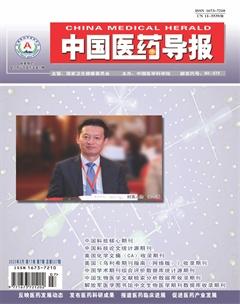顱骨成形術的研究進展
劉百雨 王忠
[摘要] 本文從顱骨成形術的必要性、術后并發癥、修補材料、修補時機等方面對顱骨成形術的研究進展進行了回顧和分析。顱骨成形術對于存在有顱骨缺損的患者來說是必要的而且可以提高其生存質量。顱骨成形術的常見并發癥包括硬膜外血腫、皮下積液積血、頭皮切口感染、顱內感染、修補材料外露及顱骨成形術后癲癇發作。早期顱骨修補相比于傳統修補存在諸多益處,其時機需根據疾病種類的不同和患者情況進行選擇;修補材料負載藥物技術和羥基石灰石骨替代技術的發展使臨床工作人員在材料的選擇上有了更多更好的選擇;計算機輔助設計和制造(CAD/CAM)等技術使自體顱骨得以在應用中展示其獨特的優點。本文對顱骨修補術在臨床上的應用提供了參考。
[關鍵詞] 顱骨成形術;并發癥;術后癲癇;修補材料
[中圖分類號] R651? ? ? ? ? [文獻標識碼] A? ? ? ? ? [文章編號] 1673-7210(2020)03(a)-0035-04
[Abstract] This article has reviewed and analyzeed the research progress of cranioplasty from the aspects of necessity, postoperative complications, repair materials, and repair timing. Cranioplasty surgery is necessary for patients with skull defects and can improve their quality of life. Common complications of cranioplasty include epidural hematoma, subcutaneous effusion, scalp incision infection, intracranial infection, exposure of repair materials, and post-cranioplasty seizures. Compared with traditional repair, early skull repair has many benefits, and its timing needs to be selected according to the type of disease and the patient′s condition; the development of repair material-loaded drug technology and the development of hydroxylimestone bone replacement technology has given clinical staff the choice of materials more and better choices; technologies such as computer-aided design and manufacturing (CAD/CAM) allow autologous skulls to demonstrate their unique advantages in their applications. This article provides a reference for the clinical application of cranioplasty.
[Key words] Cranioplasty; Complication; Post-cranioplasty seizures; Repair materials
顱骨成形術是一種重建性手術,因其可恢復顱骨減壓術后顱骨結構的完整性、改善因顱骨缺損導致的顱骨缺損綜合征而被廣泛應用[1]。當外傷性顱腦損傷或大面積腦出血引起的腦組織水腫最終發展成不能通過常規保守治療措施來有效干預的惡性顱內壓升高時,施行去骨瓣減壓術(decompressive craniectomy,DC)是挽救患者生命的有效手段。腦部急性腫脹消退后,需進行顱骨成形術以恢復顱骨的完整性和改善局部腦組織血供及腦脊液動力學。這也是恢復患者心理社會功能并促進其術后康復的重要因素。
1 顱骨修補的必要性
顱骨減壓術在挽救患者生命的同時,術后存留的顱骨缺損給患者帶來了諸多不便。術后顱骨缺損的患者可表現為記憶力減退、敏感性增高、注意力不集中、頭暈、頭痛、易疲勞、易怒及焦躁、憂慮等相關心理和軀體癥狀,臨床上稱之為顱骨缺損綜合征,即Trephined綜合征[1]。一方面,顱骨成形術可以通過恢復顱腔的物理完整性從而為患者顱骨缺損部分提供有效保護來提高患者生存質量,在降低再次受到傷害可能的同時,內環境穩態的重新建立也使腦組織血流灌注得到改善。另一方面,因減壓術后外觀上的改變所帶來的精神心理壓力降隨著修補術的結束而大大減輕。顱腔物理完整性的恢復對于患者神經功能恢復及預后而言也是一個有利的條件。
關于顱骨修補的必要性,顱骨成形術還在一些特殊病例被建議應用。Siegmund等[2]報道了1例成人慢性放射性皮膚炎伴顱骨放射性壞死的病例,指出對于放射性顱骨纖維化骨髓炎的患者,使成人慢性纖維化骨髓炎及顱骨放射性壞死是放射治療的晚期并發癥且并不常見,但是由此造成的大面積顱骨缺損仍需處理,以避免一系列并發癥,提高患者生存質量。對于DC后患者常存在的頭皮凹陷伴神經功能缺損。Park等[3]的研究指出,對于去骨瓣減壓的患者應常規進行神經功能惡化監測,當出現頭皮凹陷伴神經功能不全時患者應早期行顱骨缺損修補術。顱骨成形術同樣被用在顱骨骨髓炎的治療中,Kwiecien等[4]在回顧性分析了111例顱骨骨髓炎患者同種異體骨修補術后神經功能改善情況后提出,在清除了受感染的骨頭之后,需對患者進行延遲顱骨修補以獲得最大收益。法國學者Champeaux等[5]在對1841例惡性腦梗死后顱骨成形術患者長期生存及相關預后因素漸變分析中得出,DC患者在1年內行顱骨成形術,有助于保持良好的功能狀態。對于各個年齡段存在顱骨缺損的患者,顱骨成形術是必要的而且可以提高患者的生存質量。
6 結論
目前,關于顱骨成形術的必要性已無可爭議,對于各個年齡段存在顱骨缺損的患者,顱骨成形術是必要的而且可以提高患者的生存質量。對于顱骨修補時機來說,早期顱骨成形術存在諸多益處,關于早期修補術的時機,需根據疾病種類的不同和患者情況進行個性化選擇。關于修補材料選擇方面,修補材料負載藥物技術和羥基石灰石骨替代技術的發展使臨床工作人員在材料的選擇上有了更多選擇,使患者更多獲益。隨著VR可視技術及CAD/CAM技術的在顱骨成形術中的廣泛應用,自體顱骨以其獨特的優點,正受到越來越多的重視。
[參考文獻]
[1]? Yamaura A,Makino H. Neurological deficits in the presence of the sinking skin flap following decompressive craniectomy [J]. Neurol Med Chir(Tokyo),1977,17(1Pt1):43-53.
[2]? Siegmund BJ,Rustemeyer J. Case report:chronic inflammatory ulcer and osteoradionecrosis of the skull following radiotherapy in early childhood [J]. Oral Maxillofac Surg,2019,23(2):239-246.
[3]? Park HY,Kim S,Kim J,et al. Sinking Skin Flap Syndrome or Syndrome of the Trephined:A Report of Two Cases [J]. Ann Rehabil Med,2019,43(1):111-114.
[4]? Kwiecien G,Aliotta R,Bassiri B,et al. The Timing of Alloplastic Cranioplasty in the Setting of Previous Osteomyelitis [J]. Plast Reconstr Surg,2019,143(3):853-861.
[5]? Champeaux C,Weller J. Long-Term Survival After Decompressive Craniectomy for Malignant Brain Infarction:A 10-Year Nationwide Study [J]. Neurocrit Care,2019,9.
[6]? 湯宏,張永明,許少年,等.顱骨成形術后并發癥的臨床分析及治療策略(附158例報道)[J].中華神經創傷外科電子雜志,2017,3(1):17-20.
[7]? 王忠,蘇寧,吳日樂,等.標準大骨瓣減壓術后早期顱骨修補的選擇及并發癥的臨床分析[J].臨床神經外科雜志,2014,11(5):360-362.
[8]? 趙繼宗.神經外科學[M].2版.北京:人民衛生出版社,2012:284-285.
[9]? 王建軍,孫煒,胡安明.顱骨成形術常見因素與并發癥相關分析[J].中國現代醫學雜志,2016,26(4):138-142.
[10]? Honey S. Complications of decompressive craniectomy for head injury [J]. J Clin Neurosci,2010,17(4):430-435.
[11]? Honeybul S,Morrison DA,Ho KM. A randomized controlled trial comparing autologous cranioplasty with custom-made titanium cranioplasty [J]. J Neurosurg,2017,126(1):181-190.
[12]? Ferguson PL,Smith GM,Wannamaker BB. A population-based study of risk of epilepsy after hospitalization for traumatic brain injury [J]. Epilepsia,2010,51(5):891-898.
[13]? Wang H,Zhang K,Cao H. Seizure after cranioplasty:incidence and risk factors [J]. Craniofac Surg,2017,28(1):e560-e564.
[14]? Mukherjee S,Thakur B,Haq I. Complications of titanium cranioplasty—a retrospective analysis of 174 patients [J]. Acta Neurochir(Wien),2014,156(5):989-998.
[15]? Shih FY,Lin CC,Wang HC,et al. Risk factors for seizures after cranioplasty [J]. Seizure,2019,66:15-21.
[16]? Yao ZX,Hu X,You C. The incidence and treatment of seizures after cranioplasty:a systematic review and meta-analysis. [J]. Br J Neurosurg,2018,32(5),489-494.
[17]? Chen CC,Yeap MC,Liu ZM,et al. A Novel Protocol to Reduce Early Seizures After Cranioplasty:A Single-Center Experience [J]. World Neurosurg,2019,125:e282-e288.
[18]? Yeap MC,Chen CC,Liu ZH,et al. Postcranioplasty seizures following decompressive craniectomy and seizure prophylaxis:a retrospective analysis at a single institution [J]. J Neurosurg,2018,131(3):936-940.
[19]? Rosenthal G,Ng I,Moscovici S,et al. Polyetheretherketone implants for the repair of large cranial defects:a 3-center experience [J]. Neurosurgery,2014,75(5):523-529.
[20]? Shah AM,Jung H,Skirboll S,et al. Materials used in cranioplasty:a history and analysis [J]. Neurosurg Focus,2014,36(4):E19.
[21]? Honeybul S,Morrison DA,Ho KM,et al. A randomised controlled trial comparing autologous cranioplasty with custom-made titanium cranioplasty:long-term follow- up [J]. Acta Neurochir (Wien),2018,160(5):885-191.
[22]? Sundblom J,Gallinetti S,Birgersson U,et al. Gentamicin loading of calcium phosphate implants:implications for cranioplasty [J]. Acta Neurochir(Wien),2019,161(6):1255-1259.
[23]? Kihlstrom Burenstam Linder L,Birgersson U,Lundgren K,et al. Patient-Specific Titanium-Reinforced Calcium Phosphate Implant for the Repair and Healing of Complex Cranial Defects [J]. World Neurosurg,2019,122:e399-e407.
[24]? Beuriat PA,Lohkamp LN,Szathmari A,et al. Repair of Cranial Bone Defects in Children Using Synthetic Hydroxyapatite Cranioplasty (CustomBone) [J]. World Neurosurg,2019,129:e104-e113.
[25]? Sakamoto S,Eguchi K,Kiura Y,et al. CT perfusion imaging in the syndrome of the sinking skin flap before and after cranioplasty [J]. Clin Neurol Neurosurg,2006,108(106):583-585.
[26]? Bender A,Heulin S,R?觟hrer S,et al. Early cranioplasty may improve outcome in neurological patients with decompressive craniectomy [J]. Brain Inj,2013,27(29):1073-1079.
[27]? Lin AY,Kinsella CRJ,Rottgers SA,et al. Custom porous polyethylene implants for large-scale pediatric skull reconstruction:early outcomes [J]. J Craniofac Surg,2012, 23(21):67-70.
[28]? Van de Vijfeijken Secm,Groot C,Ubbink DT,et al. Factors related to failure of autologous cranial reconstructions after decompressive craniectomy [J]. J Craniomaxillofac Surg,2019,47(9):1420-1425.
[29]? Bjornson A,Tajsic T,Kolias AG,et al. A case series of early and late cranioplasty-comparison of surgical outcomes [J]. Acta Neurochir (Wien),2019,161(3):467-472.
[30]? Kim JH,Hwang SY,Kwon TH,et al. Defining “early” cranioplasty to achieve lower complication rates of bone flap failure:resorption and infection [J]. Acta Neurochir (Wien),2019,161(1):25-31.
[31]? Wang JS,Ter Louw RP,DeFazio MV,et al. Subtotal calvarial vault reconstruction utilizing a customized polye-theretherketone (PEEK) implant with chimeric microvascular soft tissue coverage in a patient with syndrome of the trephined:A case report [J]. Arch Plast Surg,2019, 46(4):365-370.
[32]? Sheng HS,Shen F,Zhang N,et al. Titanium mesh cranioplasty in pediatric patients after decompressive craniectomy:Appropriate timing for pre-schoolers and early school age children [J]. J Craniomaxillofac Surg,2019,47(7):1096-1103.
[33]? Ye J,Zhang W,Ye M,et al. Using titanium mesh to replace the bone flap during decompressive craniectomy:A medical hypothesis [J]. Med Hypotheses,2019,129:09257.
[34]? Zawy AS,Stroop R,Fusek I,et al. Early autologous cranioplasty:complications and identification of risk factors using virtual reality visualisation technique [J]. Br J Neurosurg,2019,13:1-7.
[35]? Musavi L,Macmillan A,Lopez J,et al. Using Computer-Aided Design/Computer-Aided Manufacturing for Autogenous,Split Calvarial Bone Graft-based Cranioplasty:Optimizing Reconstruction of Large,Complex Skull Defects [J]. J Craniofac Surg,2019,30(2):347-351.
(收稿日期:2019-11-29? 本文編輯:封? ?華)

